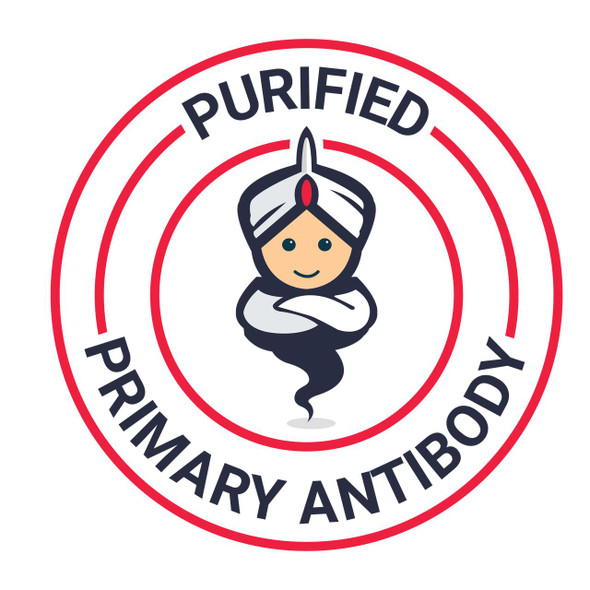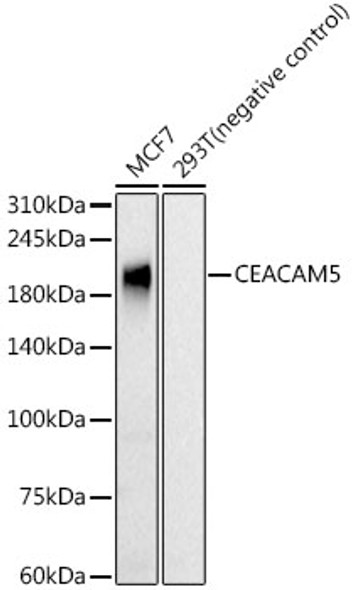Description
system_update_altDatasheet
| Product Name: | CD66eb (CEACAM5/8) monoclonal antibody |
| Product Code: | AGIM0186 |
| Size: | 100 µg in 100 µL |
| Reactivity: | Human |
| Clone: | 5C8C4 |
| Applications: | Flow Cytometry |
| Conjugate: | Unconjugated |
| Isotype: | IgG1 kappa. |
| Host Species: | Mouse |
| Storage: | Store at 4°C. For long-term storage aliquot and store at -20°C. Avoid freeze/thaw cycles |
| Uniprot: | P06731 |
| Background: | CD66e, also known as CEACAM5 (Carcinoembryonic antigen-related (CEA) cell adhesion molecule 5, is a glycosyl phosphatidyl inositol- (GPI-) anchored glycoprotein. CEACAM5 and related genes make up the CEA family belonging to the immunoglobulin superfamily. CD66e is involved in cell adhesion. Additionally it serves as pathogen receptor (e.g. Helicobacter pylori, Neisseria, Moraxella, Candida albicans). Antibodies against CEACAM5 are commonly used in immunohistochemistry to identify cells expressing the glycoprotein in tissue samples. However, CEACAM5 is also found in serum where it can be used as a tumor marker. In adults, CEACAM5 is primarily expressed in epithelia of the gastrointestinal tissue commonly together with CEACAM1, CEACAM6 and CEACAM7. CD66b, also known as CEACAM8 is a GPI-anchored glycoprotein as well. CEACAM8 is involved cell-cell communication* but does NOT serve as pathogen receptor. In adults CEACAM8 is expressed in granulocytes together with CEACAM1, CEACAM3 and CEACAM6. |
| UniProt Protein Function: | CEACAM5: Cell surface glycoprotein that plays a role in cell adhesion and in intracellular signaling. Receptor for E.coli Dr adhesins. Homodimer. Binding of E.coli Dr adhesins leads to dissociation of the homodimer. Found in adenocarcinomas of endodermally derived digestive system epithelium and fetal colon. Belongs to the immunoglobulin superfamily. CEA family. |
| UniProt Protein Details: | Protein type:Membrane protein, integral; Immunoglobulin superfamily; Membrane protein, GPI anchor Chromosomal Location of Human Ortholog: 19q13.1-q13.2 Cellular Component: basolateral plasma membrane; integral to plasma membrane Molecular Function:identical protein binding; protein homodimerization activity Biological Process: homotypic cell-cell adhesion; negative regulation of apoptosis |
| NCBI Summary: | Members of the CEACAM subfamily, including CEACAM5, belong to the CEA gene family. For general information on the CEA gene family, see CEACAM1 (MIM 109770).[supplied by OMIM, Oct 2009] |
| UniProt Code: | P06731 |
| NCBI GenInfo Identifier: | 317373456 |
| NCBI Gene ID: | 1048 |
| NCBI Accession: | P06731.3 |
| UniProt Secondary Accession: | P06731,H9KVA7, |
| UniProt Related Accession: | P06731 |
| Molecular Weight: | 76,795 Da |
| NCBI Full Name: | Carcinoembryonic antigen-related cell adhesion molecule 5 |
| NCBI Synonym Full Names: | carcinoembryonic antigen-related cell adhesion molecule 5 |
| NCBI Official Symbol: | CEACAM5 |
| NCBI Official Synonym Symbols: | CEA; CD66e |
| NCBI Protein Information: | carcinoembryonic antigen-related cell adhesion molecule 5; meconium antigen 100 |
| UniProt Protein Name: | Carcinoembryonic antigen-related cell adhesion molecule 5 |
| UniProt Synonym Protein Names: | Carcinoembryonic antigen; CEA; Meconium antigen 100 |
| Protein Family: | Colicin |
| UniProt Gene Name: | CEACAM5 |
| UniProt Entry Name: | CEAM5_HUMAN |






